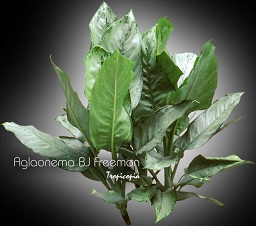Table of contents
Chinese Evergreen

Latin Name: Aglaonema ‘BJ Freeman’
Category: Aglaonema
Family: Araceae
Origin: Hybrid
Climate: Tropical
Growing Zones: 11
Care Instructions
The Chinese Evergreen (Aglaonema ‘BJ Freeman’) is a tropical plant that originates from Hybrid. This aglaonema plant belongs to the Araceae family and is well-suited for growing in USDA zones 11.
Complete Care Guide for Chinese Evergreen (Aglaonema ‘BJ Freeman’)
Watering Requirements
The Chinese Evergreen, or Aglaonema ‘BJ Freeman’, thrives in moderate moisture levels. It is essential to allow the top inch of soil to dry out between waterings. Overwatering can lead to root rot, a common issue with this plant. During the growing season, typically spring and summer, water the plant more frequently, ensuring that the pot has good drainage. In the fall and winter months, reduce watering as the plant enters a dormant phase. Always check the soil moisture with your finger before watering; if it feels damp, wait a few days before checking again. Using room temperature water is ideal, as cold water can shock the roots.
Light Conditions
Chinese Evergreens prefer bright, indirect light but can tolerate low-light conditions, making them perfect for indoor environments. Direct sunlight can scorch their leaves, leading to unsightly brown patches. Ideally, place your Aglaonema ‘BJ Freeman’ near a window with filtered light or in a well-lit room. If the leaves start to lose their vibrant color or become leggy, it may be a sign that the plant is not receiving enough light. Conversely, if you notice leaf burn, consider moving it to a shadier spot. This adaptability to various light conditions makes it a favorite among both novice and experienced gardeners.
Soil Preferences
Aglaonema ‘BJ Freeman’ thrives in well-draining potting soil that retains some moisture without becoming soggy. A mix of standard potting soil with added perlite or orchid bark can provide the ideal balance of drainage and moisture retention. The pH level should ideally be between 6.0 and 6.5. Fertilization is recommended during the growing season; use a balanced, water-soluble fertilizer diluted to half strength every 4-6 weeks. In the fall and winter, reduce or eliminate fertilization as the plant’s growth slows down. Always ensure that the pot has drainage holes to prevent water from accumulating at the bottom.
Pests and Diseases
While the Chinese Evergreen is relatively pest-resistant, it can still be susceptible to common houseplant pests such as spider mites, aphids, and mealybugs. Regularly inspect the leaves for any signs of infestation, such as webbing or sticky residue. If you notice pests, treat the plant with insecticidal soap or neem oil, ensuring to cover both the tops and undersides of the leaves. Additionally, watch for signs of diseases like root rot, which can occur from overwatering. Symptoms include yellowing leaves and a mushy stem. To prevent this, ensure proper watering practices and good drainage. If root rot occurs, remove the plant from its pot, trim away the affected roots, and repot in fresh soil.
Special Care Tips
To keep your Aglaonema ‘BJ Freeman’ healthy and thriving, consider the following special care tips: First, regularly wipe the leaves with a damp cloth to remove dust, which can hinder photosynthesis. This also helps to keep the plant looking vibrant and healthy. Additionally, rotate the pot every few weeks to ensure even growth, as the plant will naturally lean towards the light source. If you notice the plant becoming leggy, it may be time to prune back some of the longer stems to encourage bushier growth. Lastly, be cautious of cold drafts and sudden temperature changes, as Chinese Evergreens prefer a stable environment. Keeping the plant in a consistent temperature range of 65°F to 80°F (18°C to 27°C) will promote optimal growth.








